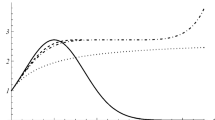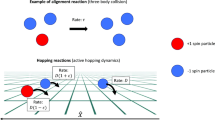Abstract
In a celebrated 1990 paper, Aizenman and Wehr proved that the two-dimensional random field Ising model has a unique infinite volume Gibbs state at any temperature. The proof is ergodic-theoretic in nature and does not provide any quantitative information. This article proves the first quantitative version of the Aizenman–Wehr theorem. The proof introduces a new method for proving decay of correlations that may be interesting in its own right. A fairly detailed sketch of the main ideas behind the proof is also included.
Similar content being viewed by others
References
Aizenman M., Wehr J.: Rounding of first-order phase transitions in systems with quenched disorder. Phys. Rev. Lett. 62(21), 2503–2506 (1989)
Aizenman M., Wehr J.: Rounding effects of quenched randomness on first-order phase transitions. Commun. Math. Phys. 130(3), 489–528 (1990)
Bovier A.: Statistical Mechanics of Disordered Systems: A Mathematical Perspective. Cambridge University Press, Cambridge (2006)
Bricmont J., Kupiainen A.: Lower critical dimension for the random-field Ising model. Phys. Rev. Lett. 59, 1829–1832 (1987)
Bricmont J., Kupiainen A.: Phase transition in the 3d random field Ising model. Commun. Math. Phys. 116(4), 539–572 (1988)
Chatterjee, S.: Disorder Chaos and Multiple Valleys in Spin Glasses. arXiv preprint arXiv:0907.3381 (2009)
Chatterjee, S.: The Ghirlanda–Guerra Identities Without Averaging. arXiv preprint arXiv:0911.4520 (2009)
Chatterjee S.: Superconcentration and Related Topics. Springer, Cham (2014)
Chatterjee S.: Absence of replica symmetry breaking in the random field Ising model. Commun. Math. Phys. 337(1), 93–102 (2015)
Houdré C., Pérez-Abreu V.: Covariance identities and inequalities for functionals on Wiener and Poisson spaces. Ann. Probab. 23(1), 400–419 (1995)
Houdré C., Pérez-Abreu V., Surgailis D.: Interpolation, correlation identities, and inequalities for infinitely divisible variables. J. Fourier Anal. Appl. 4(6), 651–668 (1998)
Imry Y., Ma S.K.: Random-field instability of the ordered state of continuous symmetry. Phys. Rev. Lett. 35, 1399–1401 (1975)
Author information
Authors and Affiliations
Corresponding author
Additional information
Communicated by H. Spohn
Research partially supported by NSF grant DMS-1608249.
Rights and permissions
About this article
Cite this article
Chatterjee, S. On the Decay of Correlations in the Random Field Ising Model. Commun. Math. Phys. 362, 253–267 (2018). https://doi.org/10.1007/s00220-018-3085-0
Received:
Accepted:
Published:
Issue Date:
DOI: https://doi.org/10.1007/s00220-018-3085-0




